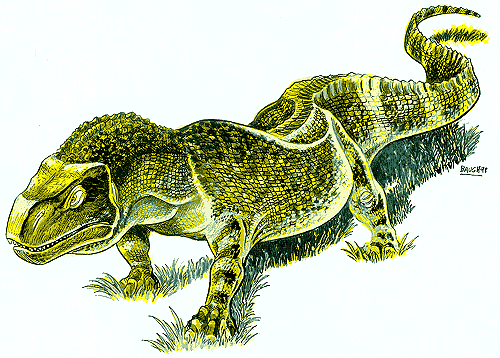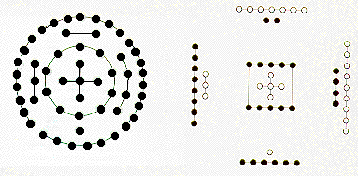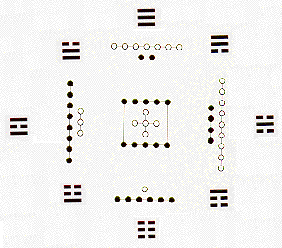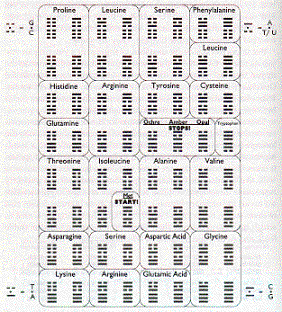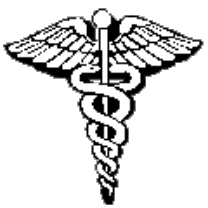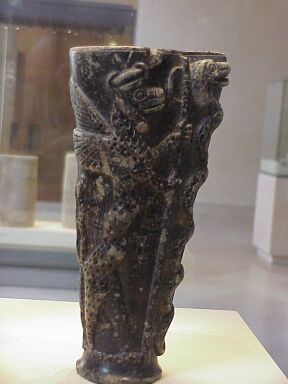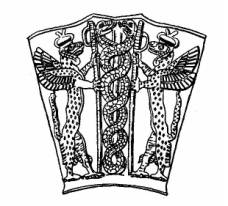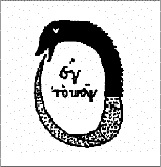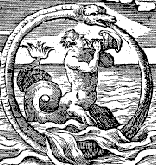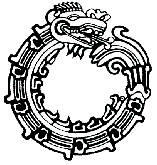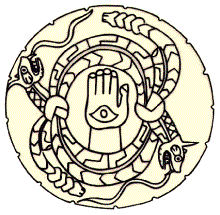American Dragons
Piasa Bird
It was August 1675. A seven-member expedition paddled west through the Straits of Mackinac, searching the middle Mississippi River region for a passage to the Pacific. The first European exploration of the area, they were led by Father Jacques Marquette, a French missionary, and Louis Jolliet, a fur-trader and cartographer.
The explorers left despite dire warnings from local Indians – there is a winged monster in the area that devours all who come near it.
Some 15 miles downstream from where the Mississippi and Illinois Rivers join, high on the rocky bluff above the Mississippi’s east bank, the adventurers saw two hideous monsters painted in yellow, green, red, and black. Father Marquette described the pictograph:
“While skirting some rocks, which by their height and length inspired awe, we saw upon one of them two painted monsters which at first made us afraid, and upon which the boldest savages dare not long rest their eyes. They are as large as a calf; they have horns on their heads like those of a deer, a horrible look, red eyes, a beard like a tiger’s, a face somewhat like a man’s, a body covered with scales, and so long a tail that it winds all around the body, passing above the head and going back between the legs, ending in a fish’s tail.”
He was describing the Piasa Bird, legendary amongst the Illini Indians of the area. Piasa (pronounced pie-a-saw) means “the bird that eats men.” The Indian myths described it as a large, winged, flesh-eating animal that lived in a cave above the river, thousands of moons before the white man came, when the magolonyn and mastodon were still living. It was much feared and would fly down and carry off anyone who came too close to the bluff. Its reign of terror ended when an Indian chief named Quatonga and twenty of his warriors managed to trick it out of its cave and kill it with poison arrows.
The commemorative paintings were lost when the bluff was quarried, however a recreation can still be seen there in the modern city of Alton, Illinois.
Professor John Russell of Bluffdale, Illinois, published an account of the Piasa in 1836. After listening to the legends, as told by the Indians, he decided to check out the cave for himself:
“Near the close of March of the present year, I was induced to visit the bluffs below the mouth of the Illinois and above that of the Piasa [Creek]. My curiosity was principally directed to the examination of a cave connected with the above traditions, as one of those to which the bird had carried its human victims Preceded by an intelligent guide who carried a spade, I set out on my excursion. The cave was extremely difficult of access, and at one point of our progress, I stood at an elevation of more than one hundred and fifty feet on the face of the bluff, with barely room to sustain one foot. The unbroken mass towered above me, while below was the river. After a long and perilous clambering, we reached the cave which was about fifty feet above the surface of the river. By the aid of a long pole placed on a projecting rock and the upper end touching the mouth of the cave, we succeeded in entering it.
“The roof of the cavern was vaulted, the top of which was hardly less than twenty-five feet in height. The shape of the cave was irregular, but so far as I could judge, the bottom would average twenty by thirty feet. The floor of this cave throughout its whole extent was a mass of human bones. Skulls and other bones were mingled together in the utmost confusion. To what depth they extended I was unable to decide, but we dug to the depth of three or four feet in every quarter of the cavern and still found only bones. The remains of thousands must have been deposited here: How, and by whom, and for what purpose, it is impossible to conjecture.”
The Piasa is the most dragon-like of the various Thunderbirds that exist within the legends of indigenous North Americans, although the Thunderbird of the Chippewa was equally as monstrous:
“The birds eyes were fire, his glance was lightning, and the motions of his wings filled the air with thunder.” [7]
The Quillayute described the Thunderbird as a very large bird, with feathers as long as a canoe paddle.
He created thunder and wind with the flap of his wings. His eyes fired lightning. If hunters got too close to his cave in the Olympic Mountains, he made thunder and rolled ice down the mountainside. His favourite food was the whale, which he caught in the ocean and ate in his cave. One time, during the Great Flood, his battle with a killer whale was so tumultuous that trees were torn up by their roots, which explains the lack of trees in Beaver Prairie today. Mountains shook. The killer whale escaped many times, each time running further away, and eventually the Thunderbird gave up. This is why the killer whales of today live deep in the oceans. [8]
Quetzalcoatlus Northropi – a giant pterosaur – lived in this region during the Mesozoic Period (65 million – 230 million years ago). It had a wingspan of 33 feet, and was possibly capable of catching killer whales. Although there are many modern stories of
these creatures still existing, they are anecdotal and lacking in evidence. But the myths of North America and other continents are strong proof that a monstrous winged lizard lived within the memories of mankind. The only counter-evidence to pterosaurs living just 10,000 years ago is the dating techniques that are championed by orthodox scientists.
Nanabozho
Nanabozho was the main character in many of the myths told by the Chippewa Indians, who once lived on the shores of Lake Superior, the setting of this story:
One day Nanabozho came home to find that his young cousin was missing. Searching for tracks he found the trail of the Great Serpent. The serpent must have taken his cousin. He packed a bow and arrows and followed the serpent’s trail. It took him over rivers, mountains and valleys to the shores of Manitou Lake. At the bottom of the lake Nanabozho could see the house of the Great Serpent. Living there with the serpent was an assortment of monstrous and evil spirits. The serpent itself, a huge multi-coloured scaly beast, was wrapped around the body of Nanabozho’s cousin.
Intent on revenge, Nanabozho utilised some of the trickery he was famous for. He ordered the clouds to disappear
and the wind to be still. When the air above the lake became stagnant, he asked the sun to burn as hot and bright as it could. If the water boiled, he thought, the serpent would leave the lake and seek the shade of the trees beside the lake.
Nanabozho found a spot near the trees, transformed himself into a tree stump and waited. The sun burned fiercely. After some time the water in the lake began to simmer. Some small serpents came up to the surface. They looked around for Nanabozho but couldn’t see him.
The water boiled. The Great Serpent rose out of the water and moved toward the shore, with his evil spirits behind him. It knew of Nanabozho’s trickery and guessed that the stump could be him in disguise. It sent some small serpents to attack it, but Nanabozho, although he was scared, kept quiet until they gave up.
The Great Serpent slipped out of the lake and sheltered under the trees, as did all its companions. Nanabozho waited until they were all asleep. When they were, he silently drew an arrow from his quiver, and fired it at the heart of the Great Serpent. His aim was true. The serpent awoke with a howl so loud that the mountains all shook. It plunged into the water, dived to the bottom and tore the body of
Nanabozho’s cousin into hundreds of pieces.
The Great Serpent knew that it would soon die from the wound, so it planned one final act of revenge. It caused the water of the lake to swell upward out over the land. The flood surged across the valleys and Nanabozho fled before it. He ran back to his village, shouting
“Run to the mountains! The Great Serpent is flooding the earth! Run! Run!”
The Indians did as he said and climbed to the top of a mountain. Nanabozho kept running until he reached a high mountain near Lake Superior, the highest mountain around. Other people were also there, seeking safety from the flood. As other mountaintops
disappeared below the water, Nanabozho made a raft out of timber and placed all the people and animals upon it. Then the highest mountain was also overwhelmed by the flood, but the people on the raft survived. After many days the floods receded and life started over again. The Great Serpent was dead. [9]
Many other stories of Nanabozho were made famous in the poem “The Song of Hiawatha” by Longfellow – with a lot of distortion from the originals, not the least being calling the hero Hiawatha instead of Nanabozho.
Quetzalcoatl
Close to Mexico City are the pyramids of Teotihuacan. They are carved with many things – including a dragon called Quetzalcoatl.
Quetzalcoatl was not an evil dragon. He was the ancient cultural hero among the Aztec, the Toltec and other Meso-American peoples. He taught them how to write and explained agriculture to them. He introduced the calendar, monotheism, music, dance and so on – in essence he civilised them. [10]
The Maya knew him as Kulkulkan, and the Quiché called him Gucumatz. The same god appeared in Zuni rituals as Kolowisi and a Hopi ritual named him as Palulukong. All of these have the same meaning: “plumed serpent”.
In his dragon form he ruled the wind, the rain and the fertility of the earth, the cycles of human sustenance. As a celestial and terrestrial being he was man’s magical connection to the mysteries of heaven and the sacred earthly realm.
Quetzalcoatl was an integral part of the creation of each of the worlds/cycles/suns of the Aztecs. The fifth age was initiated by Quetzalcoatl in 3,113 B.C. and is due to complete its cycle on Dec. 21, 2012. Just prior to the age of the fifth sun, Quetzalcoatl created man by going to the underworld and retrieving the bones of an earlier human incarnation. On his return journey he stumbled and fell, breaking the bones, and therefore the resulting people came out in all different shapes and sizes.
When he was driven away by war he promised to return to his people one day. Some accounts have him leaving in a dragon boat or on a raft of serpents. Some believe he sacrificed his human body and flew off into the sky to become the bright planet we know as Venus. [11]
To the ancients the planet Venus was seen as highly important being second to the Sun and the Moon. The ancient Greeks believed that a massive comet named ‘Phaeton’ (or ‘Blazing Star’) nearly collided with earth, setting our planet on fire before it transformed into Venus.
The ancient Assyrians knew Venus as the ‘fearful dragon…who is clothed in fire’. The Aztecs knew it as ‘The star that smoked’, and the Midrash called it the ‘brilliant light… blazing from one end of the cosmos to the other’.
Were dragons and a glowing Venus part of the same set of circumstances?
At the Mayan/Toltec ruins of Chichen Itza (Yucatan, Mexico) is “El Castle”, the pyramid of Kulkulcan / Quetzalcoatl – it is the largest and most important ceremonial structure there.
The pyramid is directionally oriented to mark the summer and winter solstices. Hence, it has often been erroneously labelled the Pyramid of the Sun, despite obviously being dedicated to Kulkulcan, the feathered serpent.
Although the original structure dates back to about 600 AD, successions of new temples were built upon previous ones through until the thirteenth century. Rising to a height of ninety feet the pyramid features many numbers important to the Maya. Each of its four-faces has a stairway with ninety-one steps (91×4 = 364). Adding the top platform gives us the number of days in the solar year. The faces incorporate 18 terraces, one for each month in the Mayan religious year, and 52 panels – every 52 years the Maya feared that the world would end.
At sunset of the vernal and autumnal equinoxes an interesting effect can be viewed, as witnessed by Graham Hancock:
“By about 5.15 in the evening it was clear what was happening. So skilfully was this magnificent pyramid aligned to the trajectory of the setting equinoctial sun that it had been possible for the ancient builders to contrive a pattern of light and shadow on the western side of the northern stairway. Very gradually, as the minutes ticked by and the sun fell lower in the sky, this pattern, which was projected by the north-western corner of the pyramid, gained in shape and substance. By around 5.30 p.m., it had manifested itself fully as a gigantic undulating serpent with seven coils of shadow defined by seven triangles of light. The tail of the serpent reached the top platform of the pyramid, with its body extending down the balustrade all the way to the ground where a huge sculpted serpent’s head with gaping jaws completed the illusion at the base of the stairway.” [12]
Elaborate panels and stone carvings featuring images of serpents appear all over the pyramid.
The association between cosmos, snakes, catastrophes and cultural deities continues…
[7] Emerson, Indian Myths. Page 34
[8] Ella E. Clark, “Quillayute” in Indian Legends of the Pacific Northwest (Berkeley: University of California Press, 1953).
